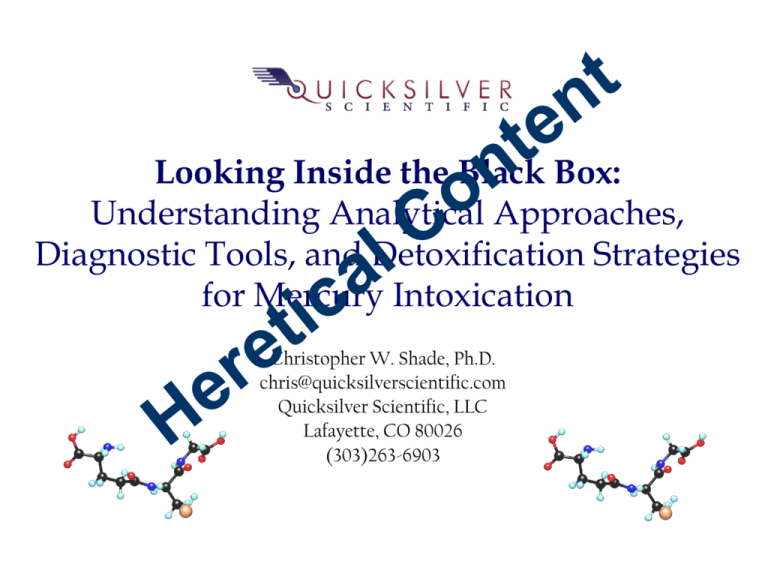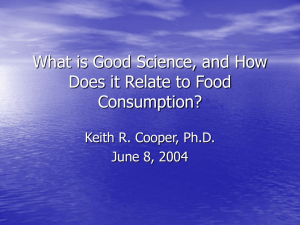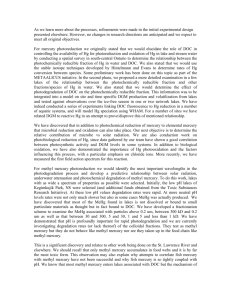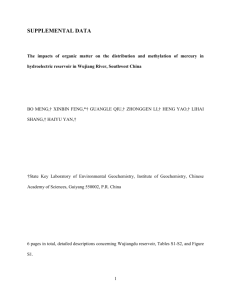Powerpoint - Vitamin C Foundation
advertisement

Looking Inside the Black Box: Understanding Analytical Approaches, Diagnostic Tools, and Detoxification Strategies for Mercury Intoxication Christopher W. Shade, Ph.D. chris@quicksilverscientific.com Quicksilver Scientific, LLC Lafayette, CO 80026 (303)263-6903 Mercury and The Human Detoxification System 1. What the key forms of Hg are 2. How the Natural Detoxification System Works 3. How the Detox System gets subverted leading to biochemical stress 4. Mercury Analysis (Blood is not a dirty word) 5. Intestinal Metals Detox System to repair and amplify the bodies Detoxification System and safely remove mercury Forms of mercury • Hg0 – Elemental Mercury – The metal form; both liquid and gas forms • HgII – Inorganic Mercury – The salt, formed by oxidation of Hg0 • MeHg - Methylmercury – Organomercurial, formed by bacterial synthesis • EtHg - Ethylmercury – Synthetic organomercurial; antimicrobial Transport of mercury • Hg0 – 80% uptake in lungs, crossed BBB, diffuses in to tissues; moderate uptake from intestines • HgII – Very poor uptakes in intestines; poor mobility; does not cross BBB • MeHg – 95% uptake from intestines, good mobility, crosses BBB • EtHg – 100% absorbtion (inj), good mobility, crosses BBB Targets of mercury forms • • • • • Brain/CNS Kidney Liver Heart Pituitary/Thyroid – And thus all glandular The Heart of the Toxicity 1. Inappropriate Binding – enzymes, redox proteins, membranes 2. Oxidative Damage and related Inflammation, including membrane damage (Parinanada) and apoptosis (cell death) The Heart of the Toxicity • Thiol Binding and Redox Reaction – Reduced sulfur groups, R-SH, – Hg replaces proton and binds to sulfur • R-SH + Hg2+ = R-SHg+ + H+ – Enzymes use thiols to anchor functional metals (Zn, Ni, Cu, Fe) – Bind and alter membrane or trigger membrane reorganization and consequent auto-oxidation – Oxidize Thioredoxin (protein repair molecule) – Deplete Glutathione system Inorganic Hg and Poisoning of the Extracellular Matrix Mercury and The Human Detoxification System 1. What the key forms of Hg are 2. How the Natural Detoxification System Works 3. How the Detox System gets subverted leading to biochemical stress 4. Mercury Analysis (Blood is not a dirty word) 5. Intestinal Metals Detox System to repair and amplify the bodies Detoxification System and safely remove mercury Defense – Glutathione System Antioxidant, Detoxification, Protein Repair • Glutathione (GSH) - A thiolic tripeptide composed of glutamate, cysteine, and glycine Defense – Glutathione System Antioxidant, Detoxification, Protein Repair • • • • • • Synthetases (synthesize GSH from precursors) Transpeptidases (take apart and reassemble) Transferases (Phase II conjugation) Peroxidases (radical quenching) Reductases (repair after quenching) Redoxins (using GSH as reducing equivalent for protein repair) • Glutathionylation – protection of Proteins – What to do? Quench the fire or protect the children? The Human Detoxification System • Detoxification Phases I, II, III – Phase I is an activation, – Phase II is conjugation – Phase III is transport (recently delineated; control point) The Human Detoxification System • Phase I - an oxidative activation, usually the Cytochrome P450 system – Prepares toxin for conjugation in Phase II with GSH, Glucuronic acid, Sulfate, Gycine or other amino acid, Taurine, Methyl group – Not needed for metals, but very important to have coupled to Phase II • Creates Essentially Free-Radicals The Human Detoxification System • Phase II – conjugation makes toxin more water soluble and recognizable by transporters – Glutathione S-Transferases (GST) responsible for GSH conjugation – Low expression in people with high MeHg and with sensitivity (allergy) to Thimerosal (EthylHg) The Human Detoxification System • Phase III is the transport out! – Several transport proteins (cMOAT, OAT, MRP1, MRP2, GS-X) • Organic Anion Transporters – Same transporters for many pathways (glucuronide, sulfate, glycinate, GSH) – In cells, liver, intestines, kidneys – biggest in liver then intestines Mercury and The Human Detoxification System 1. What the key forms of Hg are 2. How the Natural Detoxification System Works 3. How the Detox System gets subverted leading to biochemical stress 4. Mercury Analysis (Blood is not a dirty word) 5. Intestinal Metals Detox System to repair and amplify the bodies Detoxification System and safely remove mercury Breakdown of the defense system • GSH deficiency – – Genetic (GCS polymorphisms, epigenetic dysfunction) – Environmental (oxidative consumption or inflammation) • GST problems – – Genetic (GST polymorphisms, epigenetic dysfunction) – Environmental (Inflammatory cascade/ARE dysfunction) Disease and Gen Polymorphisms of GSH genes • Hemolytic Anemia – GST (Beutler et al 1988) • Sensitivity to DDT – GCS and GST (Hung et al. 2004) • Bladder Cancer (Hung et al. 2004) – O.R. GSTM1 = 1.69 – O.R. GSTT1 = 1.74 – O.R. GSTM1 + Env Exposure = 2.77 • Acute leukemia – GST Breakdown of the defense system • GSH deficiency – – Genetic (GCS polymorphisms, epigenetic dysfunction) – Environmental (oxidative consumption or inflammation) • GST problems – – Genetic (GST polymorphisms, epigenetic dysfunction) – Environmental (Inflammatory cascade/ARE dysfunction) • Phase III can get blocked and then downregulates Phase II enzymes – Can stop multiple detoxification pathways! Biggest Reason for Phase III Dysfunction Inflammation! Especially in Gut! -Hallmark of Autism cases -Easily caused by heavy metal induced oxidative damage Coordinated Expression of Phase II and III MRP2 and GSTπ coregulated Oxidative Activation Phase I Phase II Glutathione Conjugation Sulfation Blood Cellular MRP1 Phase III OATP LIVER MRP2 Normal Small Intestine Glucuronidation Oxidative Activation Phase I Phase II Glutathione Conjugation Sulfation Glucuronidation Blood Cellular MRP1 Phase III OATP LIVER MRP2 Inflamed Small Intestine Oxidative Activation Phase I Phase II Glutathione Conjugation Sulfation Glucuronidation Blood Cellular MRP1 Phase III Inflammation causes Downregulation of MRP2 OATP LIVER MRP2 Inflamed Small Intestine Negative Feedback – Inhibition of Phase II Oxidative Activation Oxidative Stress From Phase I/Phase II mismatch Phase I Build-up of both cellular and blood-borne toxins Phase III Inflammation causes Downregulation of MRP2 Sulfation Glucuronidation Cellular MRP1 Blood Phase II Glutathione Conjugation OATP LIVER MRP2 Inflamed Small Intestine Negative Feedback – Inhibition of Phase II Amalgam as Cause for Inflammation Cysteine Mouth Rinse HgII [V] [V] C:\Clarity\WORK1\20090224_Chrom _200908_0023 ARDL Waters 54 667.730 56 57 699.743 702.963 58 685.300 680.447 55 663.460 627.340 48 614.810 110 109 1575.140 0.0 1589.303 108 1570.753 1553.067 107 1557.593 105 1539.837 0.0 52 0.5 106 Voltage HgII 0.5 53 HgII 49 MeHg 630.537 MeHg 648.993 1.0 MeHg Voltage 50 1.0 644.467 51 C:\Clarity\WORK1\20090224_Chrom _200908_0023 ARDL Waters -0.5 1540 1580 1560 Time No Amalgam 25ppt MeHg, 5ppt HgII 1600 1620 [min.] 620 640 660 680 Time 700 [min.] Amalgam – 10ppb Amalgam (2nd Rinse) – 16ppb MeHg Mitochondrial Inferno – Breakdown of the Thiolic Protection System Mitochondrial Stress – The MeHg-induced Blaze 1) Covering Exposed Thiols Leaking ROS and cyt c Decay in GSH 2) Mopping up ROS 3) Binding Hg Insufficient Protection from GSH ROS and Hg Oxidize TrX TrX releases ASK1 Apoptosis – Cell Death Mercury and The Human Detoxification System 1. What the key forms of Hg are 2. How the Natural Detoxification System Works 3. How the Detox System gets subverted leading to biochemical stress 4. Mercury Analysis (Blood is not a dirty word) 5. Intestinal Metals Detox System to repair and amplify the bodies Detoxification System and safely remove mercury Testing for Hg 1. Ambient Measures 1. Blood 2. Hair 3. Urine 4. Stool 2. Provoked Measure 1. Urine Testing for Hg H H Hg H 1. Ambient 1. Blood – MeHg + HgII (MeHg larger) 2. Hair – MeHg only 3. Urine – HgII (little bit of MeHg) 4. Stool – MeHg + HgII 2. Provoked 1. Urine – MeHg + HgII Challenge Tests – What do they mean? Are They Necessary? Mercury Industry Workers Dentists Controls (Amalgam) Amalgam-free Referents Mercury Industry Workers Dentists Controls (Amalgam) Amalgam-free Referents Chelation therapy – Dump from blood followed by reloading from cellular burden Mercury Speciation Testing • Separates the two main forms of mercury in the human body – Once separately measured, ambient measurements reveal A LOT without challenge tests Whole Blood vs. RBC • Partitioning between RBC and plasma different for MeHg and HgII – MeHg 90% RBC/10% Plasma • Access to brain, intracellular, metabolic-heme – HgII 50%/50% • Lymph an extension of plasma: ~5X the volume of blood • Extracellular Matrix, also concept of terrain – Look at both forms with whole blood Inorganic Hg and Poisoning of the Extracellular Matrix …Uhhh, What Matrix? MethylMercury H H Hg The Unsuspected Factor H 1. Direct toxicity not as high as Hg(II) 1. One binding site vs. 2 major and 2 minor 2. BUT…has many insidious properties 3. Is slow to excrete bank of mercury 1. Constant source of inorganic mercury from breakdown 1. Can continue symptoms of hypersensitivity from amalgam after amalgams removed 4. Has “all-access pass” 1. Intracellular, BBB, placental barrier 5. Can form allergy that will persist till all gone 6. If phase II enzymes weak, can stay for long, long time Accumulation H H Hg H Enterohepatic Circulation of MeHg Blood Testing H H Hg • Old Dictum – blood is only recent exposure, 3-days H • Reality – 3-day residence only the quick decay after a large dose – For MeHg, Steady state develops after initial decay; Then blood reflects body burden! • Real Problem – Most labs detection limits too high to see dynamics – Need sensitive equipment! Blood Testing: The Great Tuna Experiment • 2 cans of Albacore Tuna in one sitting 2.50 24 hours later Blood MeHg (ng/mL) 2.00 24 hours later 1.50 1.00 0.50 2 hours later Pre-Tuna 2 hours later 0.00 10/26/2008 10/27/2008 10/28/2008 10/29/2008 10/30/2008 10/31/2008 Initial Decay – Redistribution to Tissues The Great(er) Walleye Experiment *Nothing is new under the sun* Clarkson et al., Arch. Env. Health, 1980 Walleye Experiment – Decay and Body Burden After initial peak and decay, Blood reflects Body Burden! Mercury Speciation Testing H H Hg H Testing for MeHg H [mV] 200 My GC - 6 (05.August 2008) H 343 Hg H 4037.647 MeHg HgII -200 MeHg 4020 4030 4040 Time 4050 346 4059.930 4055.427 4024.440 4042.010 342 344 341 -600 345 HgII -400 4019.867 Voltage 0 4060 [min.] Mercury Speciation Testing and Compartment Ratio Testing Ambient Measurement Suite 1. Blood – MeHg + HgII 2. Hair – MeHg only -Compare to blood MeHg for excretion measurement 3. Urine – HgII -Compare to blood inorganic mercury for excretion measurement Dentist Levels - Healthy Dentist Levels – Chronic Inflammation Dentist Levels – Kidney Problem Blood Mercury MeHg Patient Blood QS Average Hg(II) HgT 0.5 1 1.5 2 2.5 Concentration of Mercury (ng/m L or ug/L) Indication of Kidney Mercury Excretion Ability G o o d H g( II) E xc re t io n Line 5.00 Urine Hg(II) (ng/mL) 0 ( 7 :1) 4.50 4.00 3.50 3.00 2.50 2.00 1.50 1.00 0.50 0.00 0 0.5 1 Blood Hg(II) (ng/m L) 1.5 Patient – MeHg: Detox Enzyme Defficiency Hg Retention – Hair:Blood Normal Excretion 700 1200 600 Hair:Blood MeHg ratio Hair MeHg (ng/g) 1000 800 600 400 500 400 300 200 100 200 0 0 0.000 1.000 2.000 3.000 Blood MeHg (ng/m L) 4.000 5.000 0.000 1.000 2.000 3.000 Blood MeHg (ng/mL) 4.000 5.000 Problem of Toxicity Diagnosis • Levels can not show toxic response • Toxic response from – Abilities of your defense systems – Hyper-sensitivities/Allergies developed during exposure • Must be Diagnosed from combination of: – Clinical Symptomology, and – Auxiliary Testing Auxiliary Testing • • • • • • Allergy Testing – MELISA, ELISA Porphyrins – stress to ATP cycle and to kidneys GSH Levels – antioxidant/detoxifier defense GST Activity Trx and TrxR Genetic Susceptibilities – GCL, GSTm, GSTp, ApoE, CPox Mercury and The Human Detoxification System 1. What the key forms of Hg are 2. How the Natural Detoxification System Works 3. How the Detox System gets subverted leading to biochemical stress 4. Mercury Analysis (Blood is not a dirty word) 5. Intestinal Metals Detox System to repair and amplify the bodies Detoxification System and safely remove mercury Removal of Hg Amplifying and Augmenting Natural Systems Biochemical Hg Removal Requirements 1. Intracellular Glutathione Sufficiency -Liposomal gets in some cells -Transpeptidases dissemble/reassemble 2. Effective GST Activity (Phase II mobilization) 3. Effective Phase III Clearance including intestinal binding Product/System for Intestinal Detoxification 1. Intestinal Metals Detox (IMD) -Phase III opener (dietary supplement) 2. Phytonutrients – Antioxidant Response Element - Upregulate Transcription of Phase II, GSH, SOD via ARE 3. Source of GSH -ReadiSorb Liposomal GSH; Livon Labs -Nutritional Therapy; OSR Product/System for Intestinal Detoxification • Intestinal Metals Detox (IMD) – Use Intestines NOT Kidneys for Metal Removal – Insoluble (NON-ABSORBED) silica particles saturated with strong (thiol) binding groups – Binds Mercury in Intestines and moves out of Body • Interrupts Enterohepatic Circulation • Opens Phase III transporters – Bilirubin levels fall dramatically too! • Then relies on the Natural Detox System (GSH) Oxidative Activation Oxidative Stress From Phase I/Phase II mismatch Phase I Build-up of both cellular and blood-borne toxins Phase III Inflammation causes Downregulation of MRP2 Sulfation Glucuronidation Cellular MRP1 Blood Phase II Glutathione Conjugation OATP LIVER MRP2 Inflamed Small Intestine Negative Feedback – Inhibition of Phase II Oxidative Activation Phase I Phase II Glutathione Conjugation Sulfation Blood Cellular MRP1 Phase III OATP LIVER MRP2 Normal Small Intestine Glucuronidation Phase III Enhancement Bilirubin (unrelated to GSH) falls too Oxidative Activation Phase I Phase II Glutathione Conjugation Sulfation Glucuronidation Table 2. Bilirubin Levels on Select Patients with Elevated Blood Bilirubin (From Clinics 1 & 2, 710 interventions) Before After % Change 2 1.1 -45 1.7 0.9 -47.1 1.4 1.3 -7.1 1.2 0.9 -25.0 3.4 2.6 -23.5 1.7 1.2 -29.4 Blood Cellular MRP1 Phase III OATP LIVER MRP2 Normal Small Intestine A Look at Natural Attenuation PostRevision Halbach et al., 2008, Environ Research 107:69-78 Changes in RBC Hg after Dental Revision RevisionMeHg No Revision MeHg No Revision HgII RevisionRevision HgII Halbach et al., 2008, Environ Research 107:69-78 MeHg Moving from tissues to Bloodstream… But NOT Out! Modeled Trend Revision Modeled Trend No Revision Halbach et al., 2008, Environ Research 107:69-78 Blood Stream Decrease with Quicksilver IMD 1.4 0.5 MeHg HgII 0.45 1.2 0.4 0.35 0.3 0.8 0.25 0.6 0.2 0.15 0.4 0.1 0.2 0.05 0 11/24/2007 1/13/2008 3/3/2008 4/22/2008 6/11/2008 7/31/2008 Depressed Phase II Transferases keep MeHg in cells; Once they kick in again, enterohepatic circulation retards excretion from body 9/19/2008 0 11/8/2008 Blood HgII (ng/mL) Blood MeHg (ng/mL) 1 IMD Decreases Half-Life in Blood 1.4 0.350 blood MeHg 0.300 Fecal MeHg Excretion 1 0.250 0.8 0.200 0.6 0.150 0.4 0.100 0.2 0.050 Fecal MeHg (ng/g-ww) Blood MeHg (ng/mL) 1.2 0 0.000 08/10/08 08/20/08 08/30/08 09/09/08 09/19/08 09/29/08 10/09/08 10/19/08 10/29/08 With IMD No Treatment (Walleye) ½-Life ~ 17 days ½-Life = 46-66 days To Baseline = 40 days To Baseline = 160+ days Small Clinical Trial Results Table 3.1 Changes in blood mercury levels during 7-10 day intervention with amalgam revision and nutritional support. Clinic 1 %Decr HgT %Decr MeHg %Decr HgII IMD (n=8) 23.9 22.9 12.4 Clinic 2 No Treatment (n=4) 0.4 5.1 -4.1 IMD only (n=5) 16.3 15.9 7.1 IMD+OSR (n=7) 17.5 32.3 -15.0 Individual Trial Results Before Blood Mercury Comparison MeHg 3/14/2009 12/10/2008 QS Average Hg(II) 3 months, stopped fish consumption HgT 0 0.5 1 1.5 2 2.5 3 3.5 4 4.5 5 5.5 6 6.5 7 7.5 8 8.5 9 9.5 10 10.5 Concentration of Mercury (ng/m L or ug/L) Before Blood Mercury Comparison MeHg 8/8/2008 1/23/2009 QS Average Hg(II) 7 months while continuing to eat fish HgT 0 0.5 1 1.5 2 2.5 3 3.5 4 4.5 5 Concentration of Mercury (ng/m L or ug/L) 5.5 6 6.5 7 Patient – MeHg: Detox Enzyme Deficiency Patient – MeHg: Detox Enzyme Deficiency 2 2/12/209 4/16/2009 5/7/2009 7/8/2009 8/25/2009 1 0 2 4 6 8 10 12 14 Amalgam Removal and 5 months IMD w/ phytonutrients and nutritional therapy 16 18 20 Huggins Protocol Includes Ancestral Diet, Matrix Supplements, IMD, and OSR Blood Mercury Comparison MeHg 2/23/2009 7/6/2009 QS Average Hg(II) HgT 0 0.5 1 1.5 2 2.5 3 3.5 4 4.5 Concentration of Mercury (ng/m L or ug/L) 5 5.5 6 Product/System for Intestinal Detoxification 1. Intestinal Metals Detox (IMD) -Phase III opener 2. Phytonutrients – Antioxidant Response Element - Upregulate Transcription of Phase II, GSH, SOD 3. Source of GSH -ReadiSorb Liposomal GSH -Nutritional Therapy “Phytogenomics” • Certain Phytochemicals upregulate Phase II enzymes as well as GSH, SOD • The Anti-Inflammatory Cascade • Polyphenols • Sulfur compounds – Crucifers – Garlic oil – NOT CHELATORS!!! Also Progesterone and Pregnenolone very strong in this regard. Chemoprevention by Keap1-Nrf2 Signaling pathway by Phase II Inducers Kwak et al., 2004, Mutation Research, 555:133-148 Putting it All Together Mitochondrial Decrease Exposure/ Stress – The Hg-induced Increase Export Blaze Leaking ROS and cyt c Decay in GSH Increase GSH synthesis and Recycling Insufficient 1) Covering Exposed Thiols Increase GSH Enzyme 2) Mopping up ROS Activity 3) Binding Hg Protection from GSH ROS andTrx Hg and Oxidize Increase TrxRTrX TrX releases ASK1 Put out the Fires – Apoptosis – Cell cells Death Save the Polyphenolics • Anti-inflammatory cascade • Upregulate Phase II enzymes through binding to membrane and nuclear receptors (transcription factors) • Vascular protective effects (strengthen capillaries and improve oxygen delivery) • Anti-cancer • Cross BBB Flavanols (Polyphenolics) Ellagic Acid Epicatechin – in tea, cocoa; monomer for OPC’s from Pine Bark, Grape seeds, Quercetin Haritaki – Terminalia Chebula Haritaki – Terminalia Chebula 1. Aged rates had higher markers of mitochondrial free-radical damage 2. Also Uptick of CAT and GPx, downturn of MnSOD, GR, GST, GSH. Vit C, Vit E - normal defenses and export system can’t keep up wit the load, resulting in more accumulation of free-radical generating molecules and more reliance on downstream protections -further depleting GSH 3. ALL MARKERS REVERSED TO YOUNG LEVELS WITH HARITAKI The Clearing, The Clearing. The Great Clearing This is the path to fulfillment. So be it! Sulfur Compounds • Anti-inflammatory cascade • Upregulate Phase II (and Phase III) enzymes through binding to membrane and nuclear receptors (transcription factors) • Vascular protective effects • Anti-carcinogenic Sulfur Compounds Sulforaphane – the famous crucifer compound Erucin – from crucifers; not as strong as SF Allyl-isothiocyanate – “Oil of mustard”, horseradish Allicin – from garlic Product/System for Intestinal Detoxification 1. Intestinal Metals Detox (IMD) -Phase III opener 2. Phytonutrients – Antioxidant Response Element - Upregulate Transcription of Phase II, GSH, SOD 3. Source of GSH -ReadiSorb Liposomal GSH or Livon Labs -Nutritional Therapy Liposomal Glutathione Liposomal Encapsulation •Phospholipid bilayer •Bypasses peptidases that break down glutahione •Direct absorption in upper intestine •Some evidence that they enter cells •Macrophage oxidative damage protection Unilamellar liposomes Nutritional GSH Augmentation • Vitamin C • Antioxidant Phytonutrients • Glutathione Precursors • NAC, glutamate, glycine • NAC and Vit C • Whey powder • GGC – gamma glutamyl cysteine (product in development from Australia) Summary • Retention Toxicity Related to Dysfunction of Natural Glutathione Detox System, BUT Affects other detox systems • Inflammation as major impediment to detox • MeHg a hidden danger with amalgam • Hg speciation testing and Compartment Ratio Analysis to monitor detox • Opening channels and upregulating natural system a safe and effective detox strategy Thank You Huggins Alliance! Organic Anion Transporters: GSH Ionization in Aqueous Solutions H2O _ Mercuric DiGlutathione DiAnion Hg(GSH)2-2 - Soluble, mobile, recognizable -2 Hg MethylMercuric Glutathione MonoAnion CH3Hg(GSH)-1 - Soluble, mobile, recognizable CH3 Hg -1 Cruciferous Compounds Sulforaphane – the famous crucifer compound Glucosinolate Glucobrassicin Indole-3-Carbinol Transformations of mercury • • • • • Hg0 HgII (saliva, blood and tissues) HgII Hg0 (intestines) HgII MeHg (intestines) MeHg HgII (intestines, tissues) EtHg HgII (tissues, blood) Small Clinical Trial Results Table 3.1 Changes in blood mercury levels during 7-10 day intervention with amalgam revision and nutritional support. Clinic 1 %Decr HgT %Decr MeHg %Decr HgII IMD (n=8) 23.9 22.9 12.4 Clinic 2 No Treatment (n=4) 0.4 5.1 -4.1 IMD only (n=5) 16.3 15.9 7.1 IMD+OSR (n=7) 17.5 32.3 -15.0 Individual Trial Results Before Blood Mercury Comparison MeHg 3/14/2009 12/10/2008 QS Average Hg(II) HgT 0 0.5 1 1.5 2 2.5 3 3.5 4 4.5 5 5.5 6 6.5 7 7.5 8 8.5 9 9.5 10 10.5 Concentration of Mercury (ng/m L or ug/L) Before Blood Mercury Comparison MeHg 8/8/2008 1/23/2009 QS Average Hg(II) HgT 0 0.5 1 1.5 2 2.5 3 3.5 4 4.5 5 Concentration of Mercury (ng/m L or ug/L) 5.5 6 6.5 7







